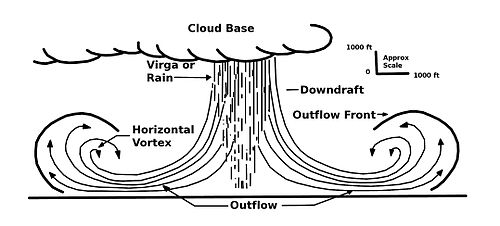Our area didn't even make it into a SEE TEXT region, yet with our moderately unstable air and weak wind shear environment, conditions were favorable for pulse thunderstorms which were capable of producing a phenomenon called DOWNBURSTS.
A pulse thunderstorm is a single-cell thunderstorm forms and dissipates relatively quickly and typically doesn't yield any severe weather. However, some pulse storms grow fast enough and drop enough rain to produce a downburst. A downburst occurs when rain-cooled air falling out of a thunderstorm hits the ground and begins to spread out in all directions. This expansion of winds (called outflow winds) can sometimes reach 100 MPH and cause quite a bit of damage! The easiest way to visualize this is to imagine pouring water out of a glass and onto the ground. As the water slams into the ground, it immediately fans out in all directions, pushing air in front of it. Is this forward motion that can drive winds as far as 50 miles away from the original storm. Here is a good visual representation, shown in cross-section. (h/t Wikipedia)
There are actually 2 varieties of downbursts - wet and dry. A wet downburst happens when rain falling out of the thunderstorm reaches the ground. A dry downburst happens when rain falling from a storm evaporates before hitting the ground. In either case, it's the outward-spreading winds from this cooler, sinking air that is responsible for causing damage. Downbursts smaller than 2.5 miles in diameter are called micro downbursts or microbursts. Downbursts greater than 2.5 miles in diameter are called macro downbursts or macrobursts.
Let's examine a real-world example of downbursts. This example begins northwest of Fort Worth, TX. At 3:02 PM, the National Weather Service issued a severe thunderstorm warning for northwest Tarrant and northeast Parker county.
Although the radar returns look unimpressive, there were some interesting things that were about to happen. One of the dangers with downbursts and the storms associated with them is the speed in which they form, drop their rain-cooled air, and eventually collapse. The following 5 snapshots of radar reflectivity and radar velocity start at 3:12 PM (about 10 minutes after the initial warning was issued) and ends at 3:31 PM - a span of only 19 minutes!!
TIME 3:12 PM
The first thunderstorm core is in the process of growing.
TIME 3:17 PM
The first thunderstorm core is still in the process of growing, while a new core is forming to the northwest.
TIME 3:22 PM
The first thunderstorm core has matured fully and has begun to produce a downburst (visible on the right side of the image). The velocity view clearly shows that winds directly underneath the thunderstorm are hitting the ground and are spreading out. The red colors indicate winds that are blowing away from the radar, while the green colors show winds blowing toward the radar. The second thunderstorm core continues to grow.
TIME 3:27 PM
The first thunderstorm core is now in the dissipating (or dying) stage. Reflectivity values (intensity of rain) has dramatically dropped off. The outflow winds from the original downburst have spread further and further apart. The second thunderstorm core continues to build up.
TIME 3:31 PM
The first thunderstorm core is now simply an area of heavy rain, while the second thunderstorm core has finally reached its mature stage. It too has begin to form a downburst beneath itself as indicated by the diverging velocity signatures.
Let me reiterate that these 2 thunderstorm cores formed, matured, created downbursts, and began to dissipate in about 30 minutes total. When damage can occur from these storms in such a small amount of time, it's crucial to be aware of the weather in your area. Boaters and others enjoying open waters are likelier to get caught off guard as the there is little in the way to shield outflow winds that blow across these bodies of water. Luckily, the downbursts in northwest Tarrant county did not produce any damage to my knowledge. However, numerous power outages along with downed power lines and trees were reported just north of the downtown Dallas area due so similar conditions.
-Andrew










